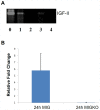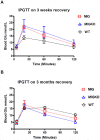Re-expression of IGF-II is important for beta cell regeneration in adult mice
- PMID: 22970135
- PMCID: PMC3436856
- DOI: 10.1371/journal.pone.0043623
Re-expression of IGF-II is important for beta cell regeneration in adult mice
Abstract
Background: The key factors which support re-expansion of beta cell numbers after injury are largely unknown. Insulin-like growth factor II (IGF-II) plays a critical role in supporting cell division and differentiation during ontogeny but its role in the adult is not known. In this study we investigated the effect of IGF-II on beta cell regeneration.
Methodology/principal findings: We employed an in vivo model of 'switchable' c-Myc-induced beta cell ablation, pIns-c-MycER(TAM), in which 90% of beta cells are lost following 11 days of c-Myc (Myc) activation in vivo. Importantly, such ablation is normally followed by beta cell regeneration once Myc is deactivated, enabling functional studies of beta cell regeneration in vivo. IGF-II was shown to be re-expressed in the adult pancreas of pIns-c-MycER(TAM)/IGF-II(+/+) (MIG) mice, following beta cell injury. As expected in the presence of IGF-II beta cell mass and numbers recover rapidly after ablation. In contrast, in pIns-c-MycER(TAM)/IGF-II(+/-) (MIGKO) mice, which express no IGF-II, recovery of beta cell mass and numbers were delayed and impaired. Despite failure of beta cell number increase, MIGKO mice recovered from hyperglycaemia, although this was delayed.
Conclusions/significance: Our results demonstrate that beta cell regeneration in adult mice depends on re-expression of IGF-II, and supports the utility of using such ablation-recovery models for identifying other potential factors critical for underpinning successful beta cell regeneration in vivo. The potential therapeutic benefits of manipulating the IGF-II signaling systems merit further exploration.
Conflict of interest statement
Figures






Similar articles
-
c-Myc directly induces both impaired insulin secretion and loss of β-cell mass, independently of hyperglycemia in vivo.Islets. 2010 Jan-Feb;2(1):37-45. doi: 10.4161/isl.2.1.10196. Islets. 2010. PMID: 21099292
-
Paracrine recruitment and activation of fibroblasts by c-Myc expressing breast epithelial cells through the IGFs/IGF-1R axis.Int J Cancer. 2019 Nov 15;145(10):2827-2839. doi: 10.1002/ijc.32613. Epub 2019 Aug 23. Int J Cancer. 2019. PMID: 31381136
-
Pro-Insulin-Like Growth Factor-II Ameliorates Age-Related Inefficient Regenerative Response by Orchestrating Self-Reinforcement Mechanism of Muscle Regeneration.Stem Cells. 2015 Aug;33(8):2456-68. doi: 10.1002/stem.2045. Epub 2015 May 26. Stem Cells. 2015. PMID: 25917344
-
Effects of c-MYC activation on glucose stimulus-secretion coupling events in mouse pancreatic islets.Am J Physiol Endocrinol Metab. 2008 Jul;295(1):E92-102. doi: 10.1152/ajpendo.90235.2008. Epub 2008 Apr 15. Am J Physiol Endocrinol Metab. 2008. PMID: 18413670
-
The many lives of Myc in the pancreatic β-cell.J Biol Chem. 2021 Jan-Jun;296:100122. doi: 10.1074/jbc.REV120.011149. Epub 2020 Dec 2. J Biol Chem. 2021. PMID: 33239359 Free PMC article. Review.
Cited by
-
Early life antibiotic exposure affects pancreatic islet development and metabolic regulation.Sci Rep. 2017 Feb 2;7:41778. doi: 10.1038/srep41778. Sci Rep. 2017. PMID: 28150721 Free PMC article.
-
Paternal Insulin-like Growth Factor 2 (Igf2) Regulates Stem Cell Activity During Adulthood.EBioMedicine. 2017 Feb;15:150-162. doi: 10.1016/j.ebiom.2016.11.035. Epub 2016 Dec 3. EBioMedicine. 2017. PMID: 28007480 Free PMC article.
-
Menin and PRMT5 suppress GLP1 receptor transcript and PKA-mediated phosphorylation of FOXO1 and CREB.Am J Physiol Endocrinol Metab. 2017 Aug 1;313(2):E148-E166. doi: 10.1152/ajpendo.00241.2016. Epub 2017 Mar 7. Am J Physiol Endocrinol Metab. 2017. PMID: 28270438 Free PMC article.
-
The Parasite-Derived Peptide, FhHDM-1, Selectively Modulates miRNA Expression in β-Cells to Prevent Apoptotic Pathways Induced by Proinflammatory Cytokines.J Diabetes Res. 2024 Jul 10;2024:8555211. doi: 10.1155/2024/8555211. eCollection 2024. J Diabetes Res. 2024. PMID: 39022651 Free PMC article.
-
A CCR2+ myeloid cell niche required for pancreatic β cell growth.JCI Insight. 2017 Aug 3;2(15):e93834. doi: 10.1172/jci.insight.93834. eCollection 2017 Aug 3. JCI Insight. 2017. PMID: 28768911 Free PMC article.
References
-
- Li Y, Hansotia T, Yusta B, Ris F, Halban PA, et al. (2003) Glucagon-like peptide-1 receptor signaling modulates beta cell apoptosis. J Biol Chem 278: 471–478. - PubMed
-
- Xu G, Stoffers DA, Habener JF, Bonner-Weir S (1999) Exendin-4 stimulates both beta-cell replication and neogenesis, resulting in increased beta-cell mass and improved glucose tolerance in diabetic rats. Diabetes 48: 2270–2276. - PubMed
-
- Drab SR (2009) Clinical studies of liraglutide, a novel, once-daily human glucagon-like peptide-1 analog for improved management of type 2 diabetes mellitus. Pharmacotherapy 29: 43S–54S. - PubMed
-
- Buse JB, Rosenstock J, Sesti G, Schmidt WE, Montanya E, et al. (2009) Liraglutide once a day versus exenatide twice a day for type 2 diabetes: a 26-week randomised, parallel-group, multinational, open-label trial (LEAD-6). Lancet 374: 39–47. - PubMed
-
- Bock T (2004) The source(s) for new pancreatic beta cells in adult life. Bioessays 26: 1156–1159. - PubMed
Publication types
MeSH terms
Substances
Grants and funding
LinkOut - more resources
Full Text Sources
Medical
Molecular Biology Databases
Research Materials

